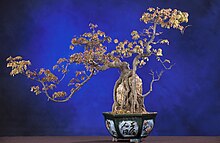| Penjing | |||||||||||||||||||||
|---|---|---|---|---|---|---|---|---|---|---|---|---|---|---|---|---|---|---|---|---|---|
 Penjing in root-over-rock style on display at the Chinese Penjing Collection of the National Bonsai and Penjing Museum in Washington, D.C. | |||||||||||||||||||||
| Chinese | 盆景 | ||||||||||||||||||||
| Literal meaning | tray scenery | ||||||||||||||||||||
| |||||||||||||||||||||
| Alternative Chinese name | |||||||||||||||||||||
| Chinese | 盆栽 | ||||||||||||||||||||
| Literal meaning | tray cultivation | ||||||||||||||||||||
| |||||||||||||||||||||
Penjing, also known as penzai, is the ancient Chinese art of depicting artistically formed trees, other plants, and landscapes in miniature.
Penjing generally fall into one of three categories:[1]
- Shumu penjing (樹木盆景): Tree penjing that focuses on the depiction of one or more trees and optionally other plants in a container, with the composition's dominant elements shaped by the creator through trimming, pruning, and wiring.
- Shanshui penjing (山水盆景): Landscape penjing that depicts a miniature landscape by carefully selecting and shaping rocks, which are usually placed in a container in contact with water. Small live plants are placed within the composition to complete the depiction.
- Shuihan penjing (水旱盆景): A water and land penjing style that effectively combines the first two, including miniature trees and optionally miniature figures and structures to portray a landscape in detail.
Chinese cultural hegemony gave the practice influence over other cultures, engendering bonsai and saikei in Japan, as well as the miniature living landscapes of hòn non bộ in Vietnam. Generally speaking, tree penjing specimens differ from bonsai by allowing a wider range of tree shapes (more "natural-looking") and by planting them in bright-colored and creatively shaped pots. In contrast, bonsai are more simplified in shape (more "minimal" in appearance) with larger-in-proportion trunks and are planted in unobtrusive, low-sided containers with simple lines and muted colors.
While saikei depicts living landscapes in containers, like water and land penjing, it does not use miniatures to decorate the living landscape. Hòn non bộ focuses on depicting landscapes of islands and mountains, usually in contact with water and decorated with live trees and other plants. Like water and land penjing, hòn non bộ specimens can feature miniature figures, vehicles, and structures. Distinctions among these traditional forms have been blurred by some practitioners outside of Asia, as enthusiasts explore the potential of local plant and pot materials without strict adherence to traditional styling and display guidelines.
- ^ Zhao Qingquan (2012). Penjing: The Chinese Art of Bonsai. Shanghai Press and Publishing Development Company. p. 11.